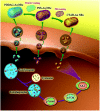Cytotoxicity-Related Bioeffects Induced by Nanoparticles: The Role of Surface Chemistry
- PMID: 31921818
- PMCID: PMC6920110
- DOI: 10.3389/fbioe.2019.00414
Cytotoxicity-Related Bioeffects Induced by Nanoparticles: The Role of Surface Chemistry
Abstract
Nanoparticles (NPs) are widely used in a variety of fields, including those related to consumer products, architecture, energy, and biomedicine. Once they enter the human body, NPs contact proteins in the blood and interact with cells in organs, which may induce cytotoxicity. Among the various factors of NP surface chemistry, surface charges, hydrophobicity levels and combinatorial decorations are found to play key roles inregulating typical cytotoxicity-related bioeffects, including protein binding, cellular uptake, oxidative stress, autophagy, inflammation, and apoptosis. In this review, we summarize the recent progress made in directing the levels and molecular pathways of these cytotoxicity-related effects by the purposeful design of NP surface charge, hydrophobicity, and combinatorial decorations.
Keywords: PEG; charge; cytotoxicity; hydrophobicity; nanoparticles; surface chemistry.
Copyright © 2019 Sun, Jiang, Wu, Bai and Zhai.
Figures








Similar articles
-
Zinc oxide nanoparticles induce apoptosis and autophagy in human ovarian cancer cells.Int J Nanomedicine. 2017 Sep 5;12:6521-6535. doi: 10.2147/IJN.S140071. eCollection 2017. Int J Nanomedicine. 2017. PMID: 28919752 Free PMC article.
-
Surface engineering of inorganic nanoparticles for imaging and therapy.Adv Drug Deliv Rev. 2013 May;65(5):622-48. doi: 10.1016/j.addr.2012.08.015. Epub 2012 Sep 6. Adv Drug Deliv Rev. 2013. PMID: 22975010 Review.
-
Surface Exposure of PEG and Amines on Biodegradable Nanoparticles as a Strategy to Tune Their Interaction with Protein-Rich Biological Media.Nanomaterials (Basel). 2019 Sep 20;9(10):1354. doi: 10.3390/nano9101354. Nanomaterials (Basel). 2019. PMID: 31547212 Free PMC article.
-
Modulation of cell responses to Ag-(MeO2 MA-co-OEGMA): Effects of nanoparticle surface hydrophobicity and serum proteins on cellular uptake and toxicity.J Biomed Mater Res A. 2018 Apr;106(4):1061-1071. doi: 10.1002/jbm.a.36302. Epub 2017 Dec 23. J Biomed Mater Res A. 2018. PMID: 29193748
-
Nanoparticles induce apoptosis via mediating diverse cellular pathways.Nanomedicine (Lond). 2018 Nov;13(22):2939-2955. doi: 10.2217/nnm-2018-0167. Epub 2018 Nov 20. Nanomedicine (Lond). 2018. PMID: 30457034 Review.
Cited by
-
Gamma-Camera Direct Imaging of the Plasma and On/Intra Cellular Distribution of the 99mTc-DPD-Fe3O4 Dual-Modality Contrast Agent in Peripheral Human Blood.Materials (Basel). 2024 Jan 9;17(2):335. doi: 10.3390/ma17020335. Materials (Basel). 2024. PMID: 38255503 Free PMC article.
-
Free and Poly-Methyl-Methacrylate-Bounded BODIPYs: Photodynamic and Antimigratory Effects in 2D and 3D Cancer Models.Cancers (Basel). 2022 Dec 23;15(1):92. doi: 10.3390/cancers15010092. Cancers (Basel). 2022. PMID: 36612089 Free PMC article.
-
Efficacy of Green Cerium Oxide Nanoparticles for Potential Therapeutic Applications: Circumstantial Insight on Mechanistic Aspects.Nanomaterials (Basel). 2022 Jun 20;12(12):2117. doi: 10.3390/nano12122117. Nanomaterials (Basel). 2022. PMID: 35745455 Free PMC article. Review.
-
The Role of Crosslinker Content of Positively Charged NIPAM Nanogels on the In Vivo Toxicity in Zebrafish.Pharmaceutics. 2023 Jul 7;15(7):1900. doi: 10.3390/pharmaceutics15071900. Pharmaceutics. 2023. PMID: 37514086 Free PMC article.
-
Comprehensive Analysis of lncRNA-mRNA Expression Profiles in Depression-like Responses of Mice Related to Polystyrene Nanoparticle Exposure.Toxics. 2023 Jul 10;11(7):600. doi: 10.3390/toxics11070600. Toxics. 2023. PMID: 37505566 Free PMC article.
References
Publication types
LinkOut - more resources
Full Text Sources
Miscellaneous

